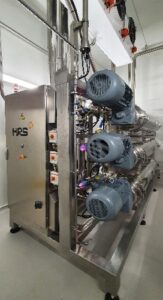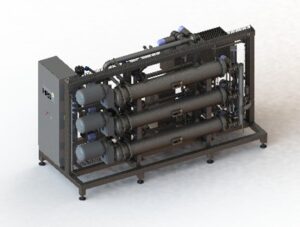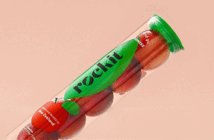Meat slurry and mechanically deboned meat (MDM) products are often processed when warm or at room temperature. However, due to the nature of both product and co-product streams, this can limit the shelf life and holding potential of such products. Cooling meat slurry and similar materials can extend their shelf life and open new markets and processing options.
A leading Australian supplier of poultry products has improved the quality of waste products produced at one of its facilities by implementing a new cooling solution from HRS Heat Exchangers.

Director for HRS Heat Exchangers, Chris Little
The plant in question produces a range of butchered and prepared chicken products, and therefore also generates waste in the form of trimmings and material not required for human consumption, such as ground chicken necks, backs, and feet. The new equipment supplied by HRS allows this material to be sold as a pet food ingredient.

Scraped-surface heat exchangers were required because of the highly viscous nature of the MDM being cooled
Australian regulations mean that ingredients for both human and animal consumption must be kept at an appropriate temperature (typically below 4°C) during processing. Because of the highly viscous nature of the material, and the risk of freezing during cooling, it was determined that a scraped-surface heat exchanger would thoroughly mix the product during cooling and prevent freezing. The thick, viscous nature of the material means that a phenomenon known as ‘slugging’ can occur. This means a channel of warmer product travels down the centre while the product at the tube wall does not move. As the cooling medium (in this case glycol) is less than -5°C, this creates the risk that the product at the tube wall will freeze, while the material in the centre is not cooled sufficiently.
Chris Little, Director at HRS Heat Exchangers, comments: “In a traditional tubular heat exchanger this product would be likely to freeze on the tube walls due to the low fluid velocities. The HRS R Series has scrapers that turn at high velocity, mixing the product and increasing heat transfer. As a result, we can specify a heat exchanger with a smaller surface area, lower working pressures, a smaller footprint, and lower capex compared with other designs. Due to the limited space available, creating a solution with a small footprint was a key priority for this product.”
The chilling system is based on three HRS R3 Series scraped-surface heat exchangers providing continuous cooling. Using three units in a parallel arrangement means that any two heat exchangers can continue to work (with a standard treatment capacity of 2,500 kg/hr) while the third is cleaned, serviced or just on stand-by. However, at times of peak production, all three units can be run simultaneously, giving the system a maximum treatment capacity of 3,500 kg/hr.
To ensure efficient and reliable operation with this difficult product, HRS adapted the internal scraper configuration to achieve the high performance necessary, while implementing a heavy-duty gearbox to withstand the higher torques required to keep the product moving. A glycol cooling system reduces the temperature of the product from 23°C to just 3.5°C in a continuous pass, with a total retention time of around 4 minutes. An autonomous control system ensures that any outgoing product which has not reached the required temperature is diverted back to the start of the process for further cooling.

The MDM chiller is based around three HRS R Series scraped surface heat exchangers
As well as the main heat exchangers, the system supplied included a receiving hopper with auger feed, an HRS BP8 piston pump (which is ideal for viscous materials) to propel product through the system, and the necessary heat exchangers and pump for the glycol cooling system, as well as the standalone control system. The solution was constructed from stainless steel and mounted on a skid to facilitate quick and easy installation and commissioning.
“Although this system is designed for poultry waste products, it is equally suitable for mechanically deboned meat products where the same cooling requirements exist, for example in sausage production,” says Little.
“Using three triple tube R Series heat exchangers also means that we have been able to save space and money compared to a system that would otherwise require on nine individual heat exchangers while providing the same performance capacity. Of particular interest to companies involved in meat processing is the fact that we can chill the product to very low temperatures without adverse effects.”




























































































